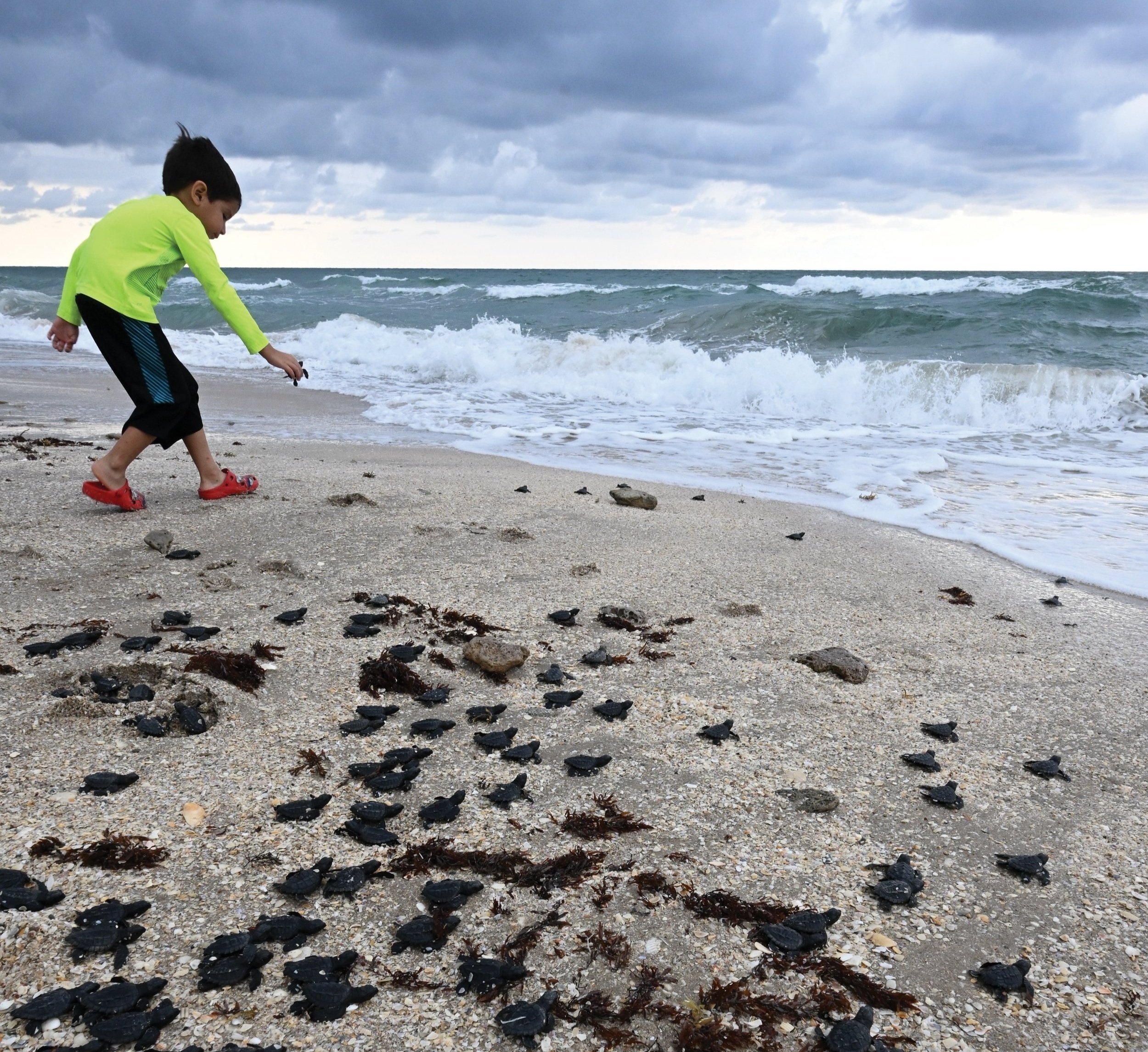How Behavioral Science (and Team BEACH) Can Help Sea Turtles
A young boy participates in a hatching release on Colola Beach in Michoacán, Mexico. © Tui de Roy/Princeton University Press
By Lindsay Mosher, Kelley Anderson, Ashleigh Bandimere, Brian Hutchinson, Roderic Mast, and Rachel Smith
Many of us who work in sea turtle conservation have experienced a moment of epiphany when it becomes clear that our work is really more about people than it is about turtles. After all, the threats to sea turtles originate from two causes: what people put into and what people take out of the seas. Sea turtle—and ocean—conservation begins and ends with people. Nonetheless, traditional conservation science has focused almost entirely on ecological and biological research. A recent study by Stefan Partelow and colleagues published in the journal Nature reports that less than 5 percent of all academic publications relating to ocean science from 1990 to 2021 were social science. Although biology and ecology undoubtedly play an important role in wildlife conservation, it is imperative that we shift our focus to the true culprit behind species loss: human behavior. It’s time to acknowledge the leatherback turtle in the room and to strike a more appropriate balance between biological and human-centered approaches to sea turtle conservation.
Moving Beyond Awareness with Team BEACH
The idea that we need to engage people in sea turtle conservation is certainly not a new one. Indeed, sea turtle conservationists worldwide have been implementing programs to reach and engage the public for decades. Overwhelmingly, those programs focus on raising awareness and educating people. The common belief—and sincere hope—is that imparting knowledge will lead to behavior change: Once people are aware of the problem and how they contribute to it, they will act.
Unfortunately, social science has widely found that knowledge and awareness alone seldom lead to behavior change. Such a disconnect stems from the complexity of what it means to be human. Logic, reason, and rational thinking do not drive our decisions and behaviors as one might expect. Rather, we are most influenced by our social identity, basic needs, desire for acceptance and belonging, worldview and value systems, and behavioral norms surrounding us. Those influences often conflict with prioritizing the conservation of wildlife.
Thankfully, there’s an entire field dedicated to understanding those complexities and using them to affect behavior change. By integrating such knowledge into sea turtle conservation, we can vastly improve the effectiveness and effect of our outreach efforts. Such an interdisciplinary approach will mean codeveloping projects with local and indigenous communities and designing outreach programs informed by behavior change metrics and social science principles. In practice, the approach may look like this:
Conducting audience research to learn about motivations and barriers that most affect behaviors underlying the conflict between humans and sea turtles
Partnering with social scientists to develop behavior change strategies and evaluations for outreach programs
Working alongside fishers to understand their needs and motivations, and designing tools that both reduce sea turtle bycatch and build operational efficiency
Collaborating with coastal communities to encourage sea turtle–friendly recreational or business practices
Acknowledging that many sea turtle conservationists do not have social science training, we have recently built a global network within the SWOT community called Team BEACH (for “Be a Changemaker”). Our aim is to build expertise that will advance effective interventions of behavior change through sharing lessons and through workshops, webinars, training, and guidelines. The graphic at the bottom of the page lists simple recommendations for incorporating behavioral science into conservation efforts.
Team BEACH Guide to Getting Started on a Behavior Change Strategy
EVALUATION IS KEY
Social science creates and is driven by a body of evidence that guides us in determining which strategies will be most successful in specific contexts. That concept should also ring true of education and outreach efforts. Evaluation is a critical concern when designing strategies for behavior change, because it can inform iterative improvement and adaptive program design. For a good start when planning for evaluation, consider the intended and clearly defined outcomes of the program and how they might be measured. We suggest partnering with a social scientist to help design a robust evaluation. As in the biological sciences, our using low-quality data stemming from poor research design or faulty methods to inform decisionmaking often has worse consequences than not having any data at all.
BE A CHANGEMAKER
Though people have been the main driver of sea turtle decline, conservationists can help people become part of the solution rather than further contributing to the problem. By learning from and implementing strategies based in social and behavioral science, we can inspire individuals, communities, businesses, decisionmakers, and future generations to embrace pro-environmental behaviors, thereby catalyzing systematic change and creating a brighter future for both people and wildlife. To join the global behavior change community for sea turtle conservation and to gain access to additional resources, visit the Team BEACH website. Join our community and help us drive change for sea turtle populations around the world by embracing the science of behavior change.
Author Affiliations
Brian Hutchinson, Oceanic Society, California, U.S.A.
Roderic Mast, Oceanic Society, California, U.S.A.
Rachel Smith, Human Nature Group, California, U.S.A
Lindsay Mosher, Oceanic Society, California, U.S.A.
Kelley Anderson, Human Nature Group, Virginia Tech, Virginia, U.S.A.
Ashleigh Bandimere, Oceanic Society, California, U.S.A.
This article originally appeared in SWOT Report, vol. 19 (2024). Download this article as a PDF.


